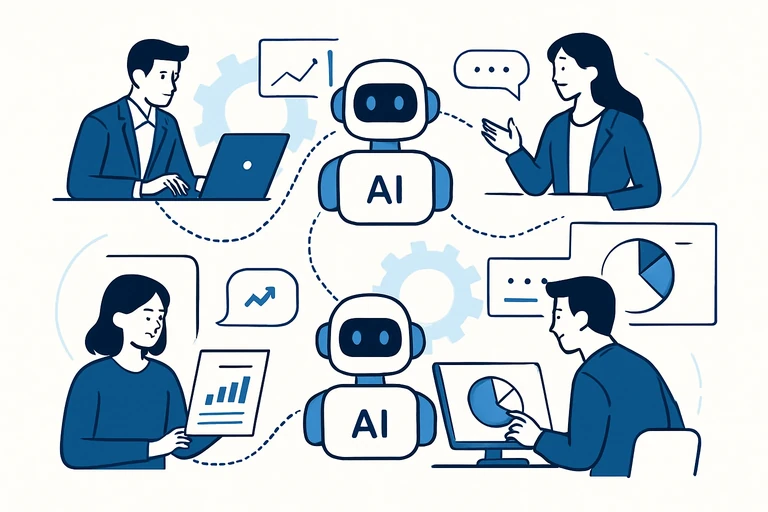The Rise of Autonomous Agents in 2025 explores practical patterns, platforms, and governance conside...

Privacy, LGPD, and the Ethical Use of AI
A practical, implementation-focused guide to navigating privacy, LGPD, and the ethical use of AI. Covers LGPD scope and rights, DPIAs, incident reporting, DPOs, and practical frameworks (NIST RMF, OECD AI Principles) with concrete steps and documentation practices (datasheets, model cards) for responsible AI.
As organizations embrace AI to unlock faster product development, better decision-making, and personalized experiences, they must also navigate the complex landscape of privacy and ethics. In Brazil, the General Data Protection Law (LGPD) defines how personal data can be collected, stored, and used, and it intersects directly with how AI systems are trained, tested, and deployed. This post offers a practical, field-ready guide for teams building AI solutions in a compliant and responsible way, with concrete steps, frameworks, and real-world considerations.
Introduction: Why LGPD and AI ethics matter now
AI technologies rely on data — often large and diverse — to train models, validate hypotheses, and continuously improve. That data may include sensitive information or data from individuals located in Brazil, triggering LGPD requirements regardless of where the data processor or model developer is based. The LGPD’s extraterritorial reach and its core privacy protections mean that responsible AI teams must design, implement, and operate in a way that respects rights to privacy, data protection, and fair treatment. At the same time, international AI ethics frameworks emphasize accountability, transparency, and human oversight — principles that align with LGPD goals and help build trust with customers and regulators alike. For a concise summary of LGPD’s scope and purpose, see official sources and analyses from Brazilian authorities and privacy experts.
1) Quick primer: what LGPD is and how it applies to AI
The LGPD is Brazil’s comprehensive data protection framework. It applies to any processing of personal data, including data collected or processed in Brazil or data related to individuals located in Brazil, even if the data controller is outside the country. The law establishes data subject rights (such as access, correction, blocking, deletion, portability, and revocation of consent) and requires that data processing be based on a lawful basis (including consent and legitimate interests, among others). It also introduces accountability and governance expectations for controllers and processors involved in data processing, including AI systems that rely on personal data. The core structure and scope are described in the law text and aligned analyses from reputable sources.
Key LGPD concepts for AI teams
- Lawful bases for processing (consent, legitimate interest, etc.).
- Data subject rights (access, correction, deletion, portability, revocation of consent).
- Automation and profiling rights, including protections around decisions made without human intervention (and the potential for human oversight where applicable).
- Data protection by design and by default as a central discipline for AI projects (see DPIA in section 3 below).
- Accountability and governance requirements for organizations that process data and build AI systems.
For a deeper dive into LGPD’s text and its application to data processing and AI, consult the official law and trusted analyses (including IAPP’s English translation and summaries).
2) LGPD and AI: rights, bases, and automated decision-making
AI projects often involve automated decision-making or profiling. LGPD Article 20 addresses automated decisions, and Article 8 outlines bases for lawful data processing, including consent and legitimate interests. In practice, teams should be prepared to demonstrate how data subjects’ rights are respected throughout model development and deployment, and to provide meaningful information about how data is used in AI workflows. Analyses from IAPP and other privacy scholars emphasize that LGPD focuses on the impact of processing on individuals, not merely on whether data is anonymized or pseudonymized. This has important implications for training data, feature engineering, and model outputs.
Practical implications for AI teams:
- Map data flows to identify where personal data is collected, stored, used for training, and transformed during inference.
- Assess the legal basis for each data processing activity (consent for training data when required, or legitimate interests with a proportionality test).
- Prepare for data subject rights responses (e.g., access requests to training data, deletion requests for models trained on personal data, etc.).
- Document automated decision-making logic and provide avenues for human review where necessary.
For a practical view of the LGPD’s approach to data processing and its alignment with AI, see official summaries and comparative analyses.
3) A practical framework: privacy by design and DPIA for AI
Privacy by design is not optional for AI — it is a discipline that reduces risk and builds trust. A Data Protection Impact Assessment (DPIA) is the customary method to evaluate high-risk processing activities, including data-heavy AI pipelines, and to plan risk mitigation ahead of deployment. ANPD has issued guidance on DPIAs and clarifications around high-risk processing areas (the LGPD itself does not enumerate every risk category, so DPIA practices help organizations stay aligned with LGPD principles).
Key steps you can implement now:
- Inventory data and map AI workflows. Identify which datasets feed training, evaluation, and inference, and tag data subjects (directly or indirectly identifiable).
- Assess risk and determine if a DPIA is required. Use the ANPD’s guidance to decide when high-risk data processing warrants a DPIA. High-risk triggers include sensitive data, large-scale processing, or profiling that could affect fundamental rights.
- Define purpose and minimization. Ensure data collection aligns strictly with defined purposes and minimize data used for training when possible.
- Document controls and governance. Detail security measures, data retention periods, access controls, and data deletion plans tied to model lifecycle.
- Use model documentation practices. Apply model cards and data sheets for datasets to communicate intended use, performance across groups, training data provenance, and limitations.
- Engage stakeholders and iterate. Include privacy, security, and domain experts in model reviews, and adjust based on findings.
There is growing guidance from Brazilian authorities and the broader privacy community on DPIAs and high-risk processing, including the ANPD’s DPIA-related resources and the broader international best practices.
Documentation tools you can adopt
- Datasheets for Datasets to describe dataset provenance, collection, and potential biases. This practice helps teams understand data quality and risk before training.
- Model Cards to accompany trained models with performance metrics, intended use cases, and caveats.
These documentation practices are widely recognized in the AI ethics community as practical tools for responsible AI. They map well to LGPD’s accountability and transparency expectations and help teams communicate risks to stakeholders and regulators.
4) Incident response and data breach notification under LGPD
The LGPD requires that controllers notify relevant authorities and data subjects about incidents that could pose risk or harm to individuals. In 2024, ANPD released a binding regulation (Regulatory Regulation on Incident Communication) that formalizes a three-business-day deadline for reporting incidents to the ANPD and, in many cases, for informing data subjects as well. The regulation also requires keeping incident logs for a defined period. These rules reinforce the need for robust monitoring, rapid detection, and clear communication channels within AI teams.
Practical takeaways for AI projects:
- Implement an incident response plan with escalation paths to legal, privacy, and security teams.
- Establish a process to detect, document, and assess incidents quickly to determine notification requirements.
- Prepare templates for concise, clear communications to both the ANPD and affected data subjects, using plain language and including the required content (nature of the data, number of data subjects, measures taken, risks, and mitigation steps).
5) Governance, accountability, and compliance in practice
Strong governance practices are essential for AI systems in any regulatory environment. Beyond LGPD’s basic rights, Brazilian authorities have issued targeted guidance on important governance topics, including the appointment of Data Protection Officers (DPOs) and transparency obligations. Recent ANPD regulations and guidance support a formal DPO role and ongoing governance activities to ensure LGPD compliance across the data lifecycle.
Related global governance frameworks—such as the NIST AI Risk Management Framework (AI RMF 1.0) and the OECD AI Principles—offer practical structures to manage AI risk and promote responsible innovation. The AI RMF introduces four core functions (Govern, Map, Measure, Manage) that organizations can tailor to their AI programs, while OECD principles emphasize accountability, transparency, fairness, privacy, and human rights. Together, these provide a robust blueprint for integrating LGPD with responsible AI practices.
6) A concrete roadmap to LGPD-aligned AI governance
Here is a compact, repeatable plan you can apply to AI initiatives today:
- Data governance foundation: inventory data, classify by risk, and ensure data lineage is auditable. Align data collection with purpose limitation and minimization.
- DPIA for high-risk AI activities: assess potential impacts on privacy and fundamental rights; document controls and residual risk. Use ANPD guidance as a reference for high-risk processing.
- AI lifecycle documentation: create model cards and datasheets for datasets to improve transparency and traceability of AI outcomes.
- Human oversight for automated decisions: implement mechanisms for human review where automated decisions impact individuals’ rights or significant interests. LGPD recognizes the importance of human involvement in certain automated processes.
- Security and incident preparedness: implement robust security controls, monitoring, and a clear incident response plan; ensure reporting timelines are understood and practiced.
- Data subject rights readiness: establish processes to respond to access, correction, deletion, and portability requests quickly and accurately. The LGPD provides these rights, and ANPD guidance clarifies response expectations.
- Continuous governance and improvement: regular audits, external assessments where needed, and updates to model documentation as data and models evolve. Leverage NIST and OECD guidance to mature governance.
7) Real-world best practices: data ethics tools for AI teams
Beyond compliance, ethical AI requires concrete tools to manage risk and promote trust. The AI ethics community has championed practical artifacts such as:
- Datasheets for Datasets to document data provenance, selection criteria, and potential biases. This helps teams anticipate issues before data is used for training.
- Model Cards to document model performance, intended use cases, and limitations across different groups. They support responsible disclosure and accountability.
- Explicit fairness and bias checks as part of evaluation (including subgroup analysis) to reduce disparate impacts in automated decisions. This aligns with OECD and NIST risk-management perspectives.
- Transparency of training data and decisions through documentation and human oversight, which helps address privacy and rights concerns in a measurable way.
8) What this means for teams building AI today
Privacy and ethics are not roadblocks to innovation — when embedded early, they become competitive differentiators. LGPD-aligned AI programs are better prepared to withstand regulatory scrutiny, earn customer trust, and avoid costly rework. Brazil’s privacy authority (ANPD) has actively issued guidance on DPIAs, DPOs, and incident reporting, signaling a maturing regulatory environment in which responsible AI thrives. For teams working with Brazilian data or serving Brazilian markets, adopting the governance patterns outlined above will pay dividends in the near term and long term.
Conclusion: Building AI with privacy, accountability, and trust
LGPD establishes a durable framework for protecting individual rights in a data-driven world, and AI ethics frameworks from OECD and NIST offer practical, scalable guidance for responsible AI. By combining privacy-by-design practices, DPIAs for high-risk activities, robust governance (including a DPO where applicable), clear incident-response plans, and transparent model documentation, organizations can innovate confidently while respecting users’ rights. In this landscape, the most resilient AI programs are those that earn trust through explicit accountability, rigorous risk management, and ethical consideration across the entire model lifecycle.
If you’re planning an AI initiative that could touch Brazilian data or data subjects, start with a data map, run a DPIA, document your datasets and models, and establish governance and incident-response protocols now. The LGPD-driven approach not only helps you stay compliant; it also demonstrates a commitment to responsible technology that respects people and their data.
Note: Multek can help you build LGPD-aligned AI programs through data mapping, DPIAs, governance design, model documentation, and secure incident response planning. This article draws on official LGPD sources and leading AI ethics frameworks to provide a practical, implementation-focused view.


